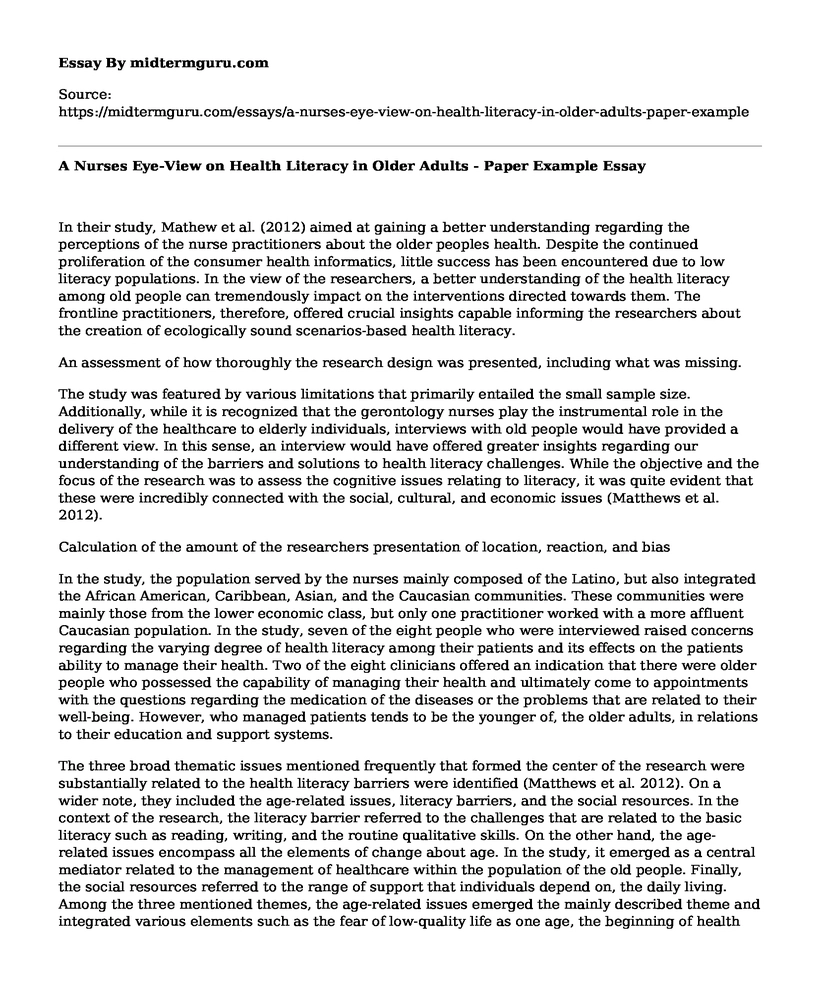In their study, Mathew et al. (2012) aimed at gaining a better understanding regarding the perceptions of the nurse practitioners about the older peoples health. Despite the continued proliferation of the consumer health informatics, little success has been encountered due to low literacy populations. In the view of the researchers, a better understanding of the health literacy among old people can tremendously impact on the interventions directed towards them. The frontline practitioners, therefore, offered crucial insights capable informing the researchers about the creation of ecologically sound scenarios-based health literacy.
An assessment of how thoroughly the research design was presented, including what was missing.
The study was featured by various limitations that primarily entailed the small sample size. Additionally, while it is recognized that the gerontology nurses play the instrumental role in the delivery of the healthcare to elderly individuals, interviews with old people would have provided a different view. In this sense, an interview would have offered greater insights regarding our understanding of the barriers and solutions to health literacy challenges. While the objective and the focus of the research was to assess the cognitive issues relating to literacy, it was quite evident that these were incredibly connected with the social, cultural, and economic issues (Matthews et al. 2012).
Calculation of the amount of the researchers presentation of location, reaction, and bias
In the study, the population served by the nurses mainly composed of the Latino, but also integrated the African American, Caribbean, Asian, and the Caucasian communities. These communities were mainly those from the lower economic class, but only one practitioner worked with a more affluent Caucasian population. In the study, seven of the eight people who were interviewed raised concerns regarding the varying degree of health literacy among their patients and its effects on the patients ability to manage their health. Two of the eight clinicians offered an indication that there were older people who possessed the capability of managing their health and ultimately come to appointments with the questions regarding the medication of the diseases or the problems that are related to their well-being. However, who managed patients tends to be the younger of, the older adults, in relations to their education and support systems.
The three broad thematic issues mentioned frequently that formed the center of the research were substantially related to the health literacy barriers were identified (Matthews et al. 2012). On a wider note, they included the age-related issues, literacy barriers, and the social resources. In the context of the research, the literacy barrier referred to the challenges that are related to the basic literacy such as reading, writing, and the routine qualitative skills. On the other hand, the age-related issues encompass all the elements of change about age. In the study, it emerged as a central mediator related to the management of healthcare within the population of the old people. Finally, the social resources referred to the range of support that individuals depend on, the daily living. Among the three mentioned themes, the age-related issues emerged the mainly described theme and integrated various elements such as the fear of low-quality life as one age, the beginning of health problems, and the isolation. Other subthemes were also identified and included family support, visiting nurse assistance, and the community support.
References
Matthews, L. A., Shine, A. L., Currie, L., Chan, C. V., & Kaufman, D. R. (2012). A Nurses Eye-View on Health
Literacy in Older Adults: NI 2012: Proceedings of the 11th International Congress on Nursing Informatics, 2012, 204.
Cite this page
A Nurses Eye-View on Health Literacy in Older Adults - Paper Example. (2021, Jun 09). Retrieved from https://midtermguru.com/essays/a-nurses-eye-view-on-health-literacy-in-older-adults-paper-example
If you are the original author of this essay and no longer wish to have it published on the midtermguru.com website, please click below to request its removal:
- Informatics for Nursing and Health Care Professionals
- The End of June: Reaction Paper
- Art Essay Sample: Migrant Mother - Photograph by Dorothea Lange
- Diabetes Among US Elderly Population - Paper Example
- 19th Century Mystery: Type 2 Diabetes - Essay Sample
- Heroin Use in US: The Increase, Benefits and Disadvantages - Essay Sample
- ANA: Unifying Nurses' Voices in the 20th Century - Research Paper







